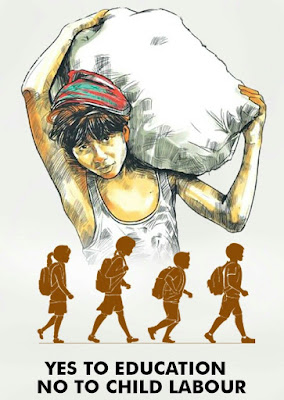World Day Against Child Labour
Saturday, 12 June
World Day Against Child Labour 2021
Child Labor is commonly used in conjunction with the term child exploitation. It is true that not all child labor is exploited, as defined by the International Labor Organization (ILO).
Child labor is commonly used in conjunction with the term child exploitation. According to the International Labor Organization (ILO) definition, it is true that not all child labor should be considered exploitative, as helping at home, looking for a small job in the summer or other similar activities can be positive. Are
The same organization has set guidelines that separate this type of work from the really harmful. in short. It is about a person who naturally deprives children of life during their childhood. These are the things that prevent them from progressing properly and with dignity.
Child labor is perceived as exploitative, harming the physical and mental development of children. They are exploited by the mafia on many occasions, the most serious of which are sexual exploitation or close slavery.
Movements are being made around the world to try to reduce the number of children who are forced to work due to various circumstances. The latest figures show that there are still an estimated 150 million children between the ages of 5 and 14 working in Asia, Africa, and Latin America with a particular case.
Reasons
Child labor, perceived as exploitation, still affects a large number of children around the world today. The effects are devastating, not only for the simple fact that the victim's childhood was stolen but also for the physical and mental health consequences.
The causes of child labor are higher than poverty, although it is the most important. In some parts of the world, there are cultural factors that explain this phenomenon.
These include gender inequality, lack of access to education, state neglect policies and other situations in which boys and girls are forced to work from an early age.
Poverty at home is a major cause of child labor. In fact, the majority of working children come from families below the poverty line.
Because of this, children will have to pay at home to survive. There are also situations wherein in some countries it may be easier for children to find a job than their parents do. Wages are low, they will not demand wage rights and they will do all the work that is required of them.
Poverty is not only a cause of child labor but also a consequence. Young children are forced to drop out of school because they are not able to get the training they need to qualify for better positions in the future. Thus, it is likely that circumstances will repeat themselves when you form your family.
The definition of "childhood" varies depending on where in the world you are born. In rural Africa or Asia, it is common for children under the age of ten to begin adult behavior, such as marriage or employment.
If these social beliefs are included in the poverty situation, it is assumed that all members of the family should survive, even the youngest.
In addition, there are often justifications such as this work instills values such as responsibility and sacrifice in children. In certain environments, his education is more important than his own education, which is limited to learning to read and write.
The rest of the teachings are considered useless, as the relatives do not believe that they have more perspective than devoting themselves to their traditional activities, be it agriculture, fishing, and other such activities.
After all, some parents even suspect that their sons, and especially daughters, go to school. He believes that education will separate them from their traditional beliefs, make them even more rebellious against the rules of the house and before their authority.
Inequality
Discrimination based on gender, race, or social group is another threat to children. These conditions complicate the integration of the labor market into education and into adulthood. After all, this is another pressure on child labor.
Gender
One of the most common types of discrimination is that it is based on gender. In many parts of the world, girls are considered worse than their siblings and are assigned chores from an early age, and are denied access to education.
In addition, girls are at higher risk of falling prey to child prostitution in some parts of the planet. Although governments are working to eliminate it, the presence of girls in prostitution has been common in some parts of Asia.
In an effort to alleviate this major problem, some European countries (where the majority of clients were) began to decide in the case of their citizens going abroad for child prostitution. Has done where he has been. No crime committed.
Access to Education
Despite the fact that, in general, education and child labor are not necessarily mutually exclusive, in most cases the children who start working drop out of school.
Lack of study opportunities is, at the same time, a major cause of child labor. Unable to go to school and receive training, the child finds himself immersed in a social dynamic that will force him to work. Also, you will not have the necessary tools to defend yourself or leave this circle.
In many countries, it has achieved the social success of offering free education. However, in some rural areas, educational offerings may be limited. Many times, the family is forced to provide materials, uniforms, and other items that it cannot afford.
Results
As mentioned above, the main result of child labor is the continuation of the vicious cycle of poverty. This puts children in jobs and prevents them from getting an education, and prevents them from finding better wages in the future.
The deception of poverty
Lack of access to education because of work, or just going to class irregularly, alleviates poverty.
Better-paying jobs not only affect the prospects for social advancement but also social norms and child labor will continue to be seen as common and inevitable.
On the other hand, the lowest age of poverty, the increase in school failure also affects academic development.
Child health
Boys and girls are not fully formed, so they are physically weaker. People who are forced to work are more likely to suffer from illness, accidents, and significant deterioration in their health.
It only increases when it has to work in hazardous activities or areas. Landslides, landmines, or city roads are places that greatly affect children's health.
After all, it is not uncommon for them to abuse their employer or others during their activities.
Psychological effects
The effects on the health of working children are not just physical. On a mental level, they also suffer from negative effects, which begin with the need to mature prematurely and cannot develop childhood-like activities.
Finally, in the medium to long term, it can lead to low self-esteem, social adaptation and trauma. Many times, they become addicted to drugs and alcohol.
Industries that employ child labor
Gold mining
This metal, highly valued in the jewelry and electronics industry, is a major cause of child labor.
Thousands of children work in underground artisanal mines. It is a work that involves extreme environmental conditions, many of which are highly toxic to the body.
Countries such as Bolivia, Colombia, Senegal and Indonesia are among the ones that employ most children for this type of work.
Cotton cultivation
As the most widely used textile fiber, this crop demands a lot of labor all over the world. In countries such as Uzbekistan, children are forced to work in their harvest during school breaks.
Brazil also has a high percentage of child labor in the sector. In these cases, social policies have not been able to contain the situation.
Sugarcane cultivation
This is a case in point, with the severity of the situation representing a greater risk for children. Heavy and sharp tools seriously compromise the health of minors.
Brick making
In countries like Nepal, Pakistan and India, it is very common for a family to send their children for bricks when they enter into a loan that they cannot repay.
Unfortunately, this practice is traditional, and that's why it's still practiced. These children often work long hours.
It is growing a lot
African and Latin American children in particular are required to work in the coffee industry.
At harvest time, they typically work ten hours a day, while at sowing, land preparation and germination, they work up to eight hours a day.






0 Comments
Thanks for your Comments